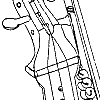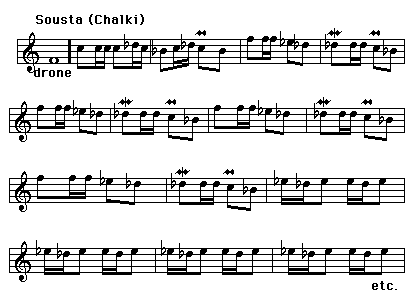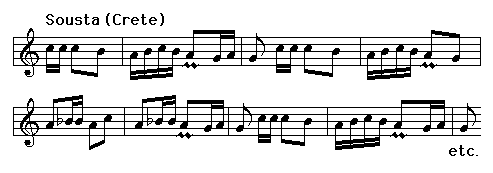 Old lyraki and new lyra |
The Cretan lyra
is a small, pear-shaped, three-string fiddle, (7) held upright and
played by stopping the strings from the side
with fingernails, widespread in Crete and the
Dodecanese. (8) The
island of Crete has been the center of the transformation
of the old lyraki, a small model of lyra devoted
only to the performance of dances, into the modern lyra,
commonly found today throughout the island (Anoyanakis 1976: 259).
This transformation took place long ago under the
influence of the violin, even if it would be difficult to
say when and why. According to Papadakis, the violin
seems to have been the main musical instrument in the
province of Chaniá in the nineteenth century, while
until the second half of the twentieth century in Western
Crete, the lyra was played mainly in the province of
Rethymnon (map). The violin exerted its influence on the lyra both
under the organological and musical aspect: it caused the
transformation of many features of the instrument and,
above all, of its tuning, performance practice, and
repertory. |
| Organology and musical language | The old lyra, or lyraki, was
tuned 5-1-4. The performer played melody on the first
string, i.e, first on player's left (psilí or kandí
or kandini) and third string (vourgara),
using the second string (mesakí) as a drone. The
player always played on two of strings (the first + the
second, or the second + the third) at the same time and
could easily perform the melody on the first and third
strings while holding the second one. While the second
and third strings were played only as open strings, the
lyrist played the first one by touching his nails from
the left side, obtaining five tones (one tone on the open
string plus four stopped tones). With the addition of the
unstopped tone of the third string, the melodic range of
the old lyra was a sixth. A musical selection displays
five of the six-tone melodic range of a sousta
recorded in Chalki and performed by V. Sfiriou on the old
type of lyra, or lyraki. |
Sousta recorded in Chalki. V. Sfiriou, lyraki |
 Dances like this, which combine the
melodic range of a sixth, the drone, and a type of melody
arranged in sequences of two-measures in 2/4, seem
related to the musical language of the askomadoura
(the Cretan bagpipe) (Magrini
1982: 69-73, 138-141). These dances were generally
accompanied by a drum.
Music like this (for instance, dances such as the sousta, the traditional dance of Rethymnon, and maleviziotis, the traditional dance of Iraklion) are still performed in Crete with the modern lyra, but performance practice as well as some musical details are different, because of the different organological aspects. |
Sousta. Gheorghios Zimakis, voice and lyra; Jakovos Fotiadis, laouto |
The modern lyra is tuned in
fifths, like the violin, uses no drone string, and all
strings (the space between which has become wider) may be
fingered and used as melody strings. This results in a
different way of performing old dance melodies, the
player now using the first and second strings (new lyra)
for the melody instead of first and third (old lyra). The
accompaniment of the laouto (which spread after
World War II) has taken the place of the drum and
compensates for the loss of the drone.
|
Syrtós Stou touphekiou ti moira. Kostas Moudakis, lyra |
But, besides the old
repertory, the new lyra, thanks to its new organological
characteristics, can perform a new and different
repertory of dances, namely the broad violin repertory of
syrtós, already performed by the lyra in the
1920s, as documented in Signell's
article. The syrtós is currently the
predominant dance in Crete and its musical language
differs from that of sousta or maleviziotis.
The melodies of the syrtós have longer phrases,
generally of wider ambitus, their performance requires
fingering all strings, in most cases, as in the syrtós
musical example played by Moudakis When playing syrtós, the lyra adopts sometimes violin virtuosic technique, as shown in this transcription fragment:
|
imitation of the violin. Silver Star. Gheorghios Zimakis, lyra |
It may also overtly and
ironically imitate the sound and repertoire of the
violin, as in Silver Star recording, performed by
Zimakis. Influence of the violin brought about profound changes in the Cretan lyra, an instrument now far removed from the old lyraki in its repertory, musical language, performance practice, and organology. The adoption of the contemporary lyra as the musical emblem of Crete to connect its present musical culture to its remote past, overlooks the transformation of the lyra and its many debts to Crete's violin tradition. As often happens, nationalism has fostered this process of transformation, instead of recovering an "uncontaminated" tradition. |


